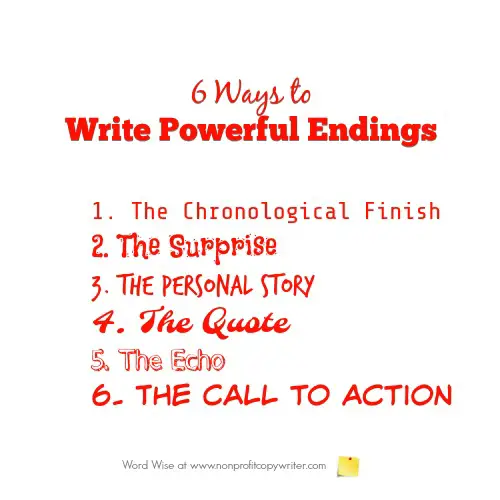Save Time: Get 5 Simple Writing Tips
you can put to use in 10 minutes
6 Tips for Writing Powerful Endings
Award-winning writer Kathy Widenhouse has helped hundreds of nonprofits and writers produce successful content , with 750K+ views for her writing tutorials. She is the author of 9 books. See more of Kathy’s content here.
By writing powerful endings to your content, you finish strong and make your point. You also make it worthwhile for your reader to stay around with you until the end.
I admit it: as I write my first draft, I'm tempted to simply summarize at the end. Sure, I made a promise to Jane Reader in my opening - with a hook - and then delivered on that promise in the body of my content. Now what?
Here is the tipping point: I want Jane to remember what she read. That’s why the key to writing powerful endings is to leave her with a short thought that she can ponder long after she has finished reading your article, letter, blog post, or other content. (And that's precisely why so many of us need to learn how to write a conclusion.)
Great news: there are lots of ways you can finish strong. Get started with these 6 types of endings that are powerful and memorable.
6 Tips for Writing Powerful Endings
1. The Chronological Finish
If your article or post recounts a series of events, use the conclusion to show “the rest of the story” – that is, what happened at the end. Let’s say you’re writing an article about a teenage daughter of a high-profile pastor who discovered she was pregnant. The article traces her pregnancy test, her confrontation with the baby’s father, and her revelation to her parents. In a chronological finish, you conclude with her choice to carry the pregnancy to term. It's memorable because it follows the well-trod story pattern of beginning-middle-end.
2. The Surprise
This ending is memorable because it catches Jane Reader off guard. As Jane moves through your article she fully anticipates that this young girl will keep her baby. But in an unexpected twist, the article reveals that the girl’s sister raises the child. A surprise ending is a way of saying to Jane Reader, “Betcha didn’t think of this!”
3. The Personal Story
This kind of ending is powerful because it’s intimate in a “Here’s-what-happened-to-me” scenario. Jane Reader is not only surprised that the young mother placed her child, but she gets chills when you reveal that the child is you, the writer - especially after she has read the content from start to finish. A personal story as an ending is authentic. For the writer, it can be cathartic, too.
4. The Quote
This is a good opportunity to allow a third party to weigh in and reinforce the main point of your piece. Words from an expert or an interviewee place a final exclamation point at the end of your article or post. As you write, be on the lookout for a quote that summarizes your concluding point. Use it to wrap up your piece. “I couldn’t have biological children on my own,” says my sister. “But I have a daughter. And a niece. All in one.”
5. The Echo
Let’s say you used an anecdote in the hook to grab the reader’s attention and illustrate your point at the beginning of your article such as, “Shania feels luckier than most adoptees. She has two moms and two aunts.”
The body of the article goes on to address the advantages and challenges of adoption by a family member.
Then you use your ending to refer back to the opening anecdote and bring Jane Reader full circle, thus the "echo" moniker. “I am Shania’s biological mom. And I am her aunt – by adoption.” This approach is a useful way to “finish what you started” and make your point memorable.
6. The Call to Action
One question always remains at the end of your piece: “Now what?” If you’ve done your job in the content, the reader will look differently at the problem now than when you presented it in the lead. You can use the ending to challenge the reader to take a step, adopt a new viewpoint, or learn more. If possible, find a way to write a call-to-action ending in second person so that the reader feels compelled to respond.
How will you wrap up your content piece? Try writing powerful endings using one of these techniques. (Hint: you just read a call-to-action ending. GRIN.)
More about The Writing Process
6 outline formats to use to organize your content ...
How to Write a Thesis Statement ...
How to Write an Introduction (or Lead, Lede, Hook) ...
Tips for Writing a Hook: Start at the End of Your Piece ...
How to write an outline for your piece of content ...
How to Write a Conclusion: 3 Tips ...
Get Powerful Content When You Ask this ONE Question ...
Repurposing Content: get 21 pieces of content from one ...
7 Content Ideas to Build Your Audience ...
What is Free Content and Why Should I Offer It?
Identity Content: 3 Tips for Explaining Who You Are and What You Do ...
Writing Blogs vs. Writing Articles: Is There a Difference?
How to Set and Achieve a Writing Goal ...
More Tips for Content Writing on our Pinterest board ...
Return from 6 Tips for Writing Powerful Endings to Nonprofit Copywriter home
As an Amazon Associate I earn from qualifying purchases.
Share This Page

Named to 2022 Writer's Digest list
BEST GENRE/NICHE WRITING WEBSITE


Stop Wasting Time!
Grab your exclusive FREE guide, "5 Simple Writing Tips You Can Put to Use in 10 Minutes or Less"












